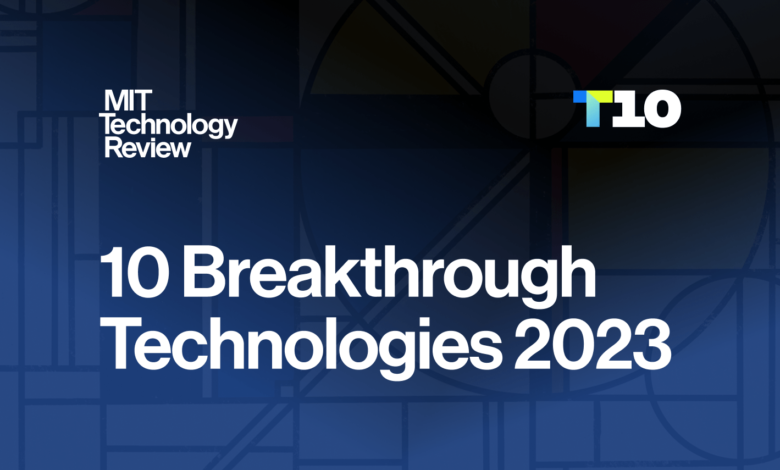MIT’s 10 breakthrough technologies for 2023 revealed

MIT Technology Review has announced its 10 Breakthrough Technologies 2023, featuring advances its reporters and editors predict will fundamentally change the way we live and work. The 22nd annual list recognizes important technological advances in artificial intelligence, biotechnology, climate change, space science, telemedicine, and more. The editorial package in the January/February Innovation issue of MIT Technology Review includes a poll to vote for the 11th breakthrough. The editors will host a conversation on LinkedIn Live today from 2-2:30 p.m. ET.
Mat Honan, editor in chief of MIT Technology Review, said: “Our breakthrough technologies lists are fascinating snapshots of the evolution of big tech innovation breakthroughs. They document the progress we have made in many of the core areas at the intersection of science and engineering. Inclusion is not an endorsement as much as it is a statement about the potential impact of a technology. Some of my favorite picks on the list this year are the ones that inspire a sense of awe and wonder at the scope of human achievement.”
The package’s intro essay, “2022’s seismic shift in US tech policy will change how we innovate,” by David Rotman, editor at large, MIT Technology Review, takes a deep dive into how legislation investing hundreds of billions into industry and research and development could reset how we think about governments’ role in the economy.
The 10 Breakthrough Technologies 2023 are:
- CRISPR for high cholesterol: New forms of the gene-editing tool could enable treatments for common conditions. WHO: Verve Therapeutics, Beam Therapeutics, Prime Medicine, Broad Institute. WHEN: 10 to 15 years. (Special story “Gene editing for everyone could be on the way,” by Jessica Hamzelou, senior reporter for biomedicine, MIT Technology Review, to post online January 19.)
- AI that makes images: AI models that generate stunning imagery from simple phrases are evolving into powerful creative and commercial tools. WHO: OpenAI, Stability AI, Midjourney, Google. WHEN: Now. (Special feature, “Generative AI is changing everything. But what’s left when the hype is gone?,” by Will Douglas Heaven, senior editor for AI, MIT Technology Review.)
- A chip design that changes everything: Computer chip designs are expensive and hard to license. That’s all about to change thanks to the popular open standard known as RISC-V. WHO: RISC-V International, Intel, SiFive, SemiFive, China RISC-V Industry Alliance. WHEN: Now. (Special story, “These simple design rules could turn the chip industry on its head,” by Sophia Chen, freelance science journalist, to post online January 25.)
- Mass-market military drones: Turkish-made aircraft like the TB2 have drastically expanded the role of drones in warfare. WHO: Baykar Technologies, Shahed Aviation Industries. WHEN: Now. (Special story, “Mass-market military drones have changed the way wars are fought,” by Kelsey D. Atherton, freelance military technology journalist, to post online January 30.)
- Abortion pills via telemedicine: Medication abortion has become increasingly common, but the US Supreme Court’s decision to overturn Roe v. Wade brought a new sense of urgency. WHO: Choix, Hey Jane, Aid Access, Just the Pill, Abortion on Demand, Planned Parenthood, Plan C. WHEN: Now.
- Organs on demand: Engineered organs could end transplant waiting lists. WHO: eGenesis, Makana Therapeutics, United Therapeutics. WHEN: 10 to 15 years. (Special feature, “The entrepreneur dreaming of a factory of unlimited organs,” by Antonio Regalado, senior editor for biomedicine, MIT Technology Review, to post online January 11.)
- The inevitable EV: Electric vehicles have been available for decades. Now they’ve finally become mainstream. WHO: BYD, Hyundai, Tesla, Volkswagen. WHEN: Now.
- James Webb Space Telescope: A marvel of precision engineering that could revolutionize our view of the early universe. WHO: NASA, European Space Agency, Canadian Space Agency, Space Telescope Science Institute. WHEN: Now. (Special feature, “How the James Webb Space Telescope broke the universe,” by Jonathan O’Callaghan, freelance space journalist, to post online January 21.)
- Ancient DNA analysis: New methods that make damaged DNA legible to commercial sequencers have produced stunning revelations about the deep past. WHO: Max Planck Institute for Evolutionary Anthropology, David Reich Lab at Harvard. WHEN: Now.
- Battery recycling: New ways to recover the crucial metals in batteries could make electric vehicles more affordable. WHO: CATL, Umicore, Redwood Materials, Li-Cycle, Cirba. WHEN: Now. (Special feature, “How old batteries will help power tomorrow’s EVs,” by Casey Crownhart, climate reporter, MIT Technology Review, to post online January 17.)
Amy Nordrum, executive editor of operations, MIT Technology Review, said: “People are excited by technology’s potential and want to understand better how it’s shaping our world. We help our audience spot new technologies as they reach a pivotal moment and see how these advances will change our future (for better or worse). We surveyed a wide range of topics, from medicine to energy to digital technologies, and tapped our staff’s deep expertise to identify emerging technologies ready to make a big impact. We look not just for promising technologies, but ones poised to truly breakthrough into the mainstream and have a real effect on the world.”
About MIT Technology Review
Founded at the Massachusetts Institute of Technology in 1899, MIT Technology Review is a world-renowned, independent media company whose insight, analysis, and interviews explain the newest technologies and their commercial, social, and political impacts. MIT Technology Review derives its authority from its relationship with the world’s foremost technology institution, its editors’ deep technical knowledge, the capacity to see technologies in their broadest context, and unequaled access to leading innovators and researchers. MIT Technology Review’s mission is to bring about better-informed and more conscious decisions about technology through authoritative, influential, and trustworthy journalism.
